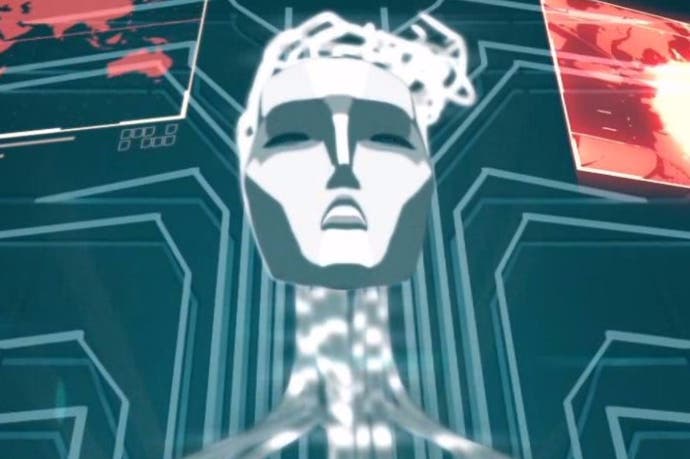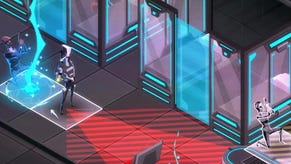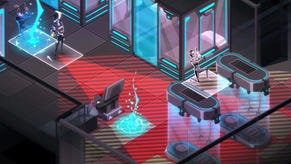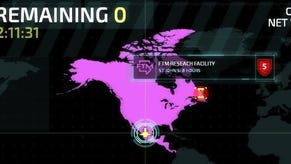Invisible, Inc review
Noiromancer.
On paper, Invisible, Inc reads like a long list of things that I already love. This is a stealthy turn-based tactics game in which you lead a squad of double-dangerous secret agents through procedurally-generated maps whose wayward sprawls are broken down into neat little tiles. The art is angular, long-limbed cartoon noir, the title's a truly stellar pun, and the whole thing's put together by Klei Entertainment, a virtuoso group of ludic shapeshifters whose last few games - Mark of the Ninja, Don't Starve - have closely orbited a core of brutal, unforgiving, economical brilliance without letting the paths intersect.
This doesn't explain why I love Invisible, Inc so much, though. To do that, you have to strike beneath the careful template and get at the behaviours that the game's rules and restrictions encourage. I love Invisible, Inc because its systems come together with one aim: to make me decisive. A ditherer by nature, it is fun to roleplay as someone so clear-eyed and free from doubt - someone who's able to ditch a team-mate when things get bad or decide, on a steely whim, if such a thing is possible, to risk absolutely everything on a hunch. With limited resources, warrenous maps, deadly enemies and short sight lines, Invisible, Inc prompts you to make one quick decision after another - and then dark emergent joy erupts as you try to live with the consequences of what you've just done.
This theme goes deep, too. Invisible, Inc's structure is seemingly pretty simple: you have 72 hours to rebuild your ravaged corporation and gear up for a final all-or-nothing mission that will probably kill you. You do this by jetting around the world and raiding rival corps, stealing new weaponry from Alaska, say, or busting a fellow agent out of a holding cell in China. With a wealth of options available at all times, you'd imagine that you're free to ignore the objectives that don't interest you and zero in on the ones that do. But that 72 hours is encouraging you to play temporal Tetris. It can take a long time to fly to Alaska, where a sweet new gun might be waiting for you - time that you could maybe spend taking in two separate missions closer to home, whose objectives, granted, you're less excited about. Getting the most out of your 72 hours is a crucial concern, then, even before you've set foot inside an enemy compound or chambered your first stun dart. This stuff matters. The first time I arrived at the final mission, I was down to a single agent, and they were armed - ha - with nothing more deadly than some reviving gel. That went well. By comparison, the last time I headed into the final mission I had four guys, and they were seriously tooled up. I still only squeaked it, though. Invisible, Inc really isn't screwing around.
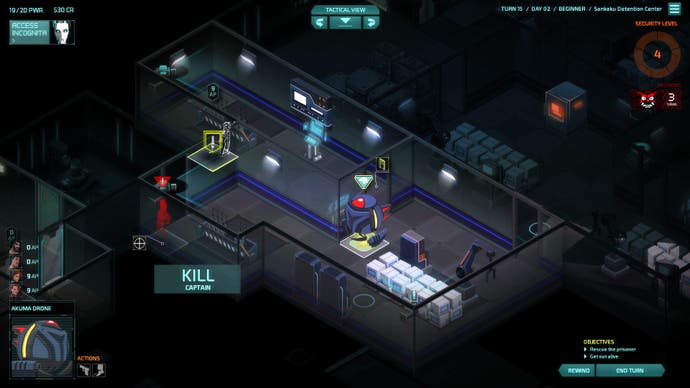
The core of the game unfolds in the missions you despatch your agents on - turn-based tactical scrambles that have been polished by a shortish spell in Early Access. When I first played Invisible, Inc last year, it was fascinating but slightly too busy: each turn you not only moved your agent, for example, but also had to decide what direction they were facing afterwards. Now, the game is far more focused, but it's lost none of its depth as ephemera has been stripped away. Movement is simple, positioning is everything, and the true thrill of the experience - the thing that really makes you feel like a spy - comes from the regular shift between the physical world, with its pot plants you can hide behind and its doors you can peek through and its action point limitations, and the Incognita layer, a digital map that covers the same territory but picks out objects you might like to hack. You know, electronic safes storing loot, spy cameras that will raise an alarm if you cross their paths but, once turned, might give you a vital glimpse into enemy territory, and even generators that control laser grids, keeping certain areas out of reach.
Hacking involves resource management, since it runs on power units that must, in most circumstances, be gathered from machines scattered around the levels, and the more stuff to hack that you uncover, the more you come to understand that you'll have to pick and choose a bit. More importantly, hacking also encourages you to shift perspectives with regularity, combining the intel from each agent on the ground with a wider view of a battlefield that you're essentially turning to your own advantage independently of your agents. This means that, for a single-player game, it can really feel like a team effort. Every victory in Invisible, Inc will probably have involved clever interaction between the real world and the Incognita view - and you can also lose very badly if you mismanage your virtual affairs. Your own hacking interface can be upgraded with a range of programs that offer handy perks - tagging enemies, say, or dialling down the power cost for certain actions. Keeping this in check, though, are enemy programs called Daemons that can do anything from limiting your movement to reclaiming cameras and barriers you'd already broken into. Hacking in Invisible, Inc is like moving out of the shadows: proceed with caution.
Satisfying stealth, the way Klei sees it, is a mixture of exploration and improvisation. On the exploration side, from the moment you're dumped into each level with a specific objective, you need to push back the fog of war one room at a time, both to find your ultimate target, whether it's a central corporate safe or a prison block, and to locate your exit. Often, the tumblers spin so that you find the exit first, and this is where Invisible, Inc really starts to bite. Every turn you spend on a mission is dangerous, since every turn raises the security level, eventually leading to new guards, new security cameras and other nasty tricks. The more you explore, in other words, the more you have to balance the rewards for a successful mission against the costs of reaching that objective. You're always thinking of the long game and of that looming final mission that you're currently so desperately unprepared for, but you're simultaneously thinking of the here-and-now: about the next door and the horrors that you might find on the other side.
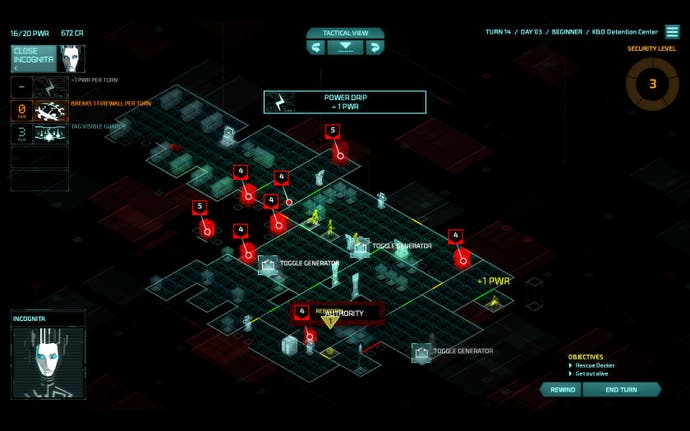
This is where improvisation comes in, and, true to turn-based tactical form, let me tell you a story about that. It's a story about Invisible, Inc's drones, which are amazing things. They are after you hack them, anyway. Before that, they're just terrifying. They patrol the game's procedural maps with a steady gaze and a restless trigger finger. One glimpse of you and you're generally in big trouble.
Last week, I was deep in a prison level, and Big Trouble seemed likely. I was leading a three-man team (my third member came from a previous prison level) and I was trying to get a potential fourth guy out of his cell and over to the magical elevators that mark the exit (in a recent update these elevators have become teleportation platforms, but the patched fiction doesn't stick: to me, they're still elevators). I had not been cautious early on, and so the corridors were filled with patrolling guards, all of whom were in hunt mode. I'd used hacked gun drones to thin their ranks a little, but my fourth guy had apparently run out of luck. The elevator was in sight, the last door had just closed behind him, but the security patrols would open that door in their next turn, and they'd gun him down before he got to safety. This was a certainly, because Invisible, Inc's systems clip together so well they are built on certainty - aside from clear markings that illustrate the game area enemies can see, if you have eyeballs on a guard you can even click to get a sense of which way they're going to move next turn. My other three operatives were out of reach, waiting in the elevator, so they couldn't help. Also, I'd lost control of most of my drones by this point, and the only one left to me had run out of bullets.
That's when it hit me. This was a perfect moment to take a drone and use it in a way that no drone should ever be used. Drones are expensive, right? AI? Lots of advanced hover technology? Plenty of moving parts. Well, I took all of that and I parked it in front of the door my fleeing fourth man had just raced through, blocking it for a single, crucial turn. In the grid-based world of Invisible, Inc, I had found a way to survive against the odds: the security guards couldn't get to the door because they couldn't get past the drone. And this drone wasn't budging.

The game's filled with moments like this. All strategy games are, of course, or at least that's the patter. Such patter undersells the achievement here, though. Perhaps due to its compact nature, Invisible, Inc has a peculiar genius for procedural narrative, for creating tense, unlikely tales filled with daring escapes and truly monumental screw-ups. It's exhausting to play at times, but that's because of the emotional investment, because of the need to process the useful stuff you've just learned and memorise the nutty stuff that just happened.
Beyond all this is a world of glittering intricacy. You start each game with just two agents, but you can gather more if you free them from prisons, so by the end of it you can be controlling a squad of four. Each agent comes with their own perks, and, on top of that, you can kit them out just as much as you can pimp your Incognita - throwing in weapons and gadgets and neural implants. There is genuine depth here when it comes to different approaches. I started off relying on Internationale, an elbowy side-eye-thrower who has the ability to reveal hackable objects in nearby rooms that she hasn't actually been to. I leant on her for an age, but now I have a sweet thing going with Dr Xu, who can place shock traps on doors. He changes the way you play - he changes the way you open doors - just as the corporations you go up against do, Sankaku with those drones, for example, Plastech with their cybernetic augmentations.
By the final mission, you have to be able to master all of this. Crucially, though, what you really need to master is the fact that direct conflict will always be more trouble than it's worth in Invisible, Inc. The moment you stun your first guard rather than slipping past their vision cone feels like a failure. Not only does killing someone automatically boost the security level and tighten the screws, merely stunning someone means that, well, they are merely stunned. Your weapons will take an age to recharge and meanwhile, you'll need to drag your stunee around and pin them beneath you if you don't want them back on active duty. With the final mission, you can expect a truly brutal series of objectives, too, one of which involves holding territory while enemies race to your location. No single agent or piece of kit will solve a problem like that: you need to consider the wider picture.
And once the final mission's done there's a scamper up the difficulty levels, alongside endless, custom and time attack modes, the latter of which works a bit like speed chess, but with people getting whacked over the head. In truth, while pleasant, this is a covering of the bases that Invisible, Inc doesn't really need. Much like the lives of one of its secret agents, this is a game defined by short, sharp thrills. It's so filled with purpose that is has no need to outstay its welcome.
